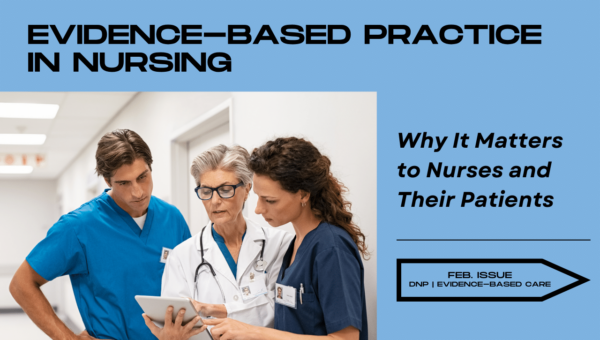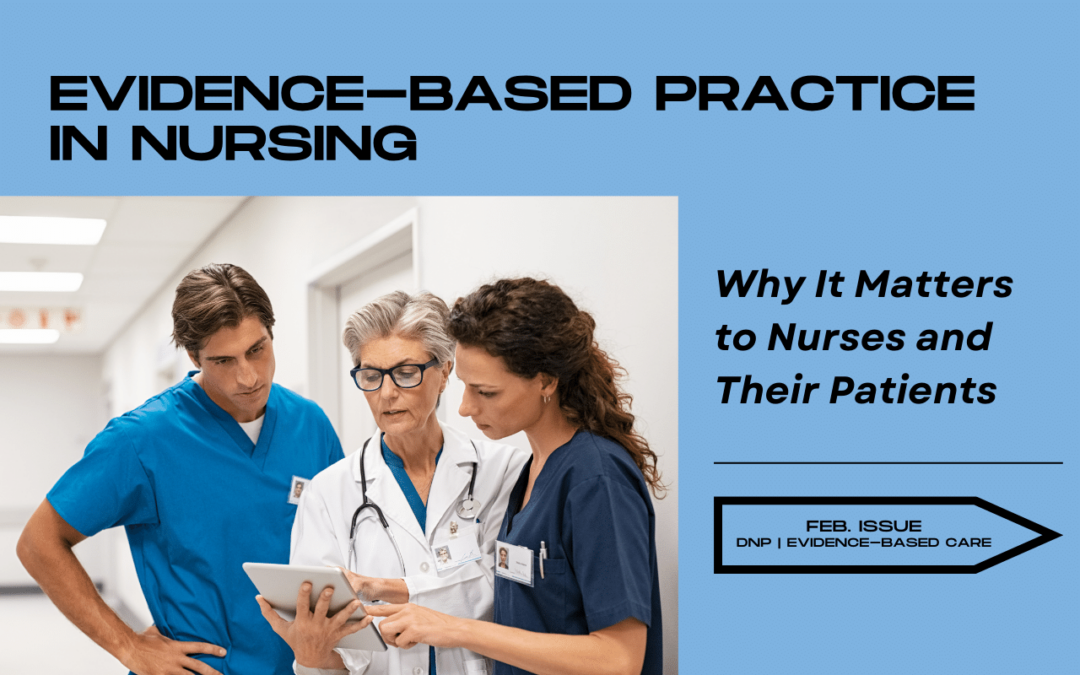Basing your nursing practice on the latest evidence and research remains critical to providing optimal patient care. Practicing nursing based on tradition, “how we’ve always done it,” or outdated research can lead to poor patient outcomes, inappropriate care, or serious errors.
No doubt you studied evidence-based practice (EBP) in school, read it in journals or attended in-service sessions about using evidence in practice. You no doubt have every intention and desire to base your nursing practice on the latest research. But how can you do that when your days quickly spin into a whirlwind of patient admissions, procedures, and more?
In this article, we’ll offer a few perspectives and approaches on ways to help base your practice on the latest evidence. But first, a quick refresher on the importance of EBP.
The Importance of Evidence
“By integrating the latest and most robust evidence into our day-to-day nursing practices, as nurses, we ensure that our interventions are grounded on the most recent or latest advancements in healthcare and patient preferences and values, thus promoting safe, effective, and high-quality care,” according to Meredith Padilla, PhD, RN, CCRN-CMC, clinical practice specialist for practice excellence at the American Association of Critical-Care Nurses (AACN). “Moreover, EBP fosters a culture of continuous learning and professional development and elevates the standards of nursing practice. Additionally, a recent study reports that EBP culture and mentorship increase job satisfaction and intent to stay among nurses.”
Highlighting the importance of bringing evidence into practice, an entire field of research is now dedicated to determining the best methods and strategies (or interventions) for facilitating the implementation of research evidence in healthcare decision-making, including day-to-day nursing practice, according to Jennifer Yost, PhD, RN, FAAN, professor, M. Louise Fitzpatrick College of Nursing, Villanova University. She notes that this is commonly referred to as implementation science, knowledge translation, or translational science.
Culture of Inquiry
In bringing evidence to the bedside, nurses must cultivate a culture of inquiry, notes Padilla. “Asking questions is the initial step toward EBP,” she says. She suggests using the PICOT format (Patient/population, Intervention, Comparison, Outcome, Time) to frame the question.
Also, use an EBP model to guide your work. Examples of EBP models, she notes, include the Iowa Model, the Johns Hopkins Evidence-Based Practice Model, the Advancing Research and Clinical Practice through Close Collaboration Model (ARCC), and the Stevens Star Model of Knowledge Transformation.
All of these models, she notes:
- Emphasize the importance of identifying and defining specific clinical questions that require EBP solutions and utilize the PICOT format guide to search for evidence.
- Share a step of conducting a systematic and thorough review of the best available evidence related to the clinical question.
- Have a common goal of the translation of evidence into clinical practice.
- Emphasize evaluation of the implementation process and continuous improvement.
Tap your resources, Padilla says. Collaborate with a colleague, nurse leader, or interdisciplinary team member who can provide support and mentorship as you explore the evidence behind a clinical question.
Along those same lines, cultivating a culture of peer review and mentorship is pivotal, says Sandra Russo, PhD, RN, director of nursing and chairperson of the nursing program at Touro University. She notes that peer-reviewed journal club meetings and mentorship programs can provide a platform for exchanging knowledge and developing critical skills.
Access to Resources
Having easy access to EBP resources is key. Hospitals and healthcare agencies should support EBP by providing nursing staff with easy access to reputable nursing journals, online databases, and institutional access to academic resources, says Russo.
In addition, don’t neglect to consult your institution’s policies and procedures, says Pamela Barnwell-Sanders, EdD, MBA, MSN, RN, associate professor of practice at Egan School of Nursing and Health Studies, Fairfield University. She says that even if you’re performing a procedure regularly, you may discover that the policy or procedure has been updated to reflect the latest evidence.
Resources to help nurses identify the best available evidence, notes Padilla, include published clinical practice guidelines research databases like PubMed, CINAHL, and the Cochrane Library.
When it comes to searching for evidence, starting a search for the already-synthesized evidence (for example, systematic reviews or clinical practice guidelines based on systematic reviews) can improve search efficiency, according to Yost. Searching repositories of evidence syntheses (for example, Epistemonikos) and databases, such as PubMed, that allow one to limit searches to systematic reviews is also helpful, she says.
Continuous Improvement
As with most aspects of healthcare, analysis and feedback are critical. Regular audits of nursing practices are necessary to assess adherence to evidence-based guidelines, notes Russo. She says constructive feedback, recognizing positive behaviors, and addressing areas requiring improvement is the cornerstone of a continuous improvement cycle.
The nurse at the bedside should always be asking why, says Barnwell-Sanders. With a firm understanding of and grounding in EBP, you’ll have a solid knowledge of why a practice or procedure provides the best evidence-based care for your patients.
Sign up now to get your free digital subscription to Minority Nurse.
- Project Austin: Serving the Special Needs of Medically Complex Children - July 9, 2024
- Practical DEI - June 13, 2024
- Making Self-care a Priority - May 9, 2024



